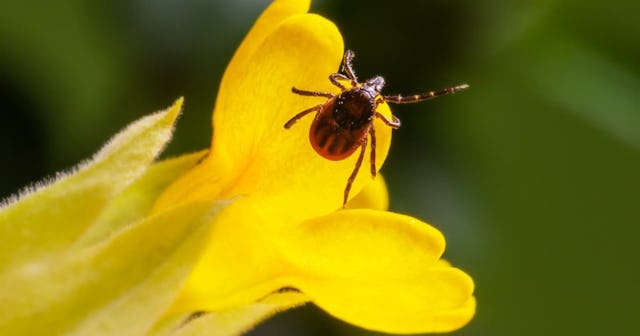How To Get Rid Of Chiggers Because They're Gross And They Bite

If you’ve ever seen a teeny tiny red bug that looks a little like a spider crawling on your skin or somewhere in your home or backyard, in addition to being horrified, you also might wonder what, exactly, you’re looking at. Or, probably even more likely, you won’t notice these pests until they’ve left large pink bites behind on your skin. These are called “chiggers,” and they’re not technically even insects: They are immature mites that are approximately 1/150th of an inch long. And, depending on where you live, you may also know them as berry bugs, harvest mites, and red bugs.
RELATED: Tick Season Is Upon Us! How To Identify And Treat Tick Bites
If you’re spending part of the pandemic gardening in the yard or out on camping trips you should be aware that these little bites will have you scratching yourself raw if you don’t treat them asap. While they can be found all over the country, they’re most common in the Southeast and Midwest. So now that you know the chigger basics, how do you get rid of these gross, annoying parasites? Here’s what you need to know.
Where do chiggers live?
Chiggers love tall grasses, brambles, and weeds, or any other dense vegetation. “Chiggers are most abundant in vegetational transition zones such as the junction of forest and grass, in swampy areas and thickets,” Jim Fredericks, Ph.D., chief entomologist and vice president of technical and regulatory affairs for the National Pest Management Association told Reader’s Digest. As we mentioned, they can and do live anywhere in the U.S., but prefer places in the Midwest and Southeast — and their location also determines how long they’ll stick around. For instance, they are most active in places like Michigan for around two months (usually towards the end of summer) but are active year-round in Florida.
What do chigger bites look like?
Got itchy red bumps? You might have had a run-in with chiggers. These bites sometimes resemble pimples, blisters, or small hives, and are often found around the waist, ankles, or warm skin folds. You can typically expect to see them in clusters. Within a few days, chigger bites can get bigger and — woe is you — itchier.
How can you avoid chigger bites?
Do Some Landscaping
We’re not talking about anything fancy here, but by clearing the weeds, brush, and tall grasses from your yard, you can take away their homes and hiding places. This is especially true if you have any areas that are overgrown — that’s like a chigger wonderland. “Homeowners should remove brush and thickets, and be sure to keep the lawn mowed, as these tactics will help reduce chigger populations,” Fredericks added. In fact, keeping your grass short does more than add curb appeal to your home: per the article, it also raises soil temperatures and lowers the humidity, meaning that chiggers are less likely to make their home in your yard.
Keep Them Off Your Body
The most annoying thing about chiggers is that they bite. If you’re not sure what a chigger bite looks like, it can take the form of welts, blisters, pimples, or hives. If you notice a bright red dot in the center of a bite, it’s a remnant of the tube your skin formed in response to the chigger’s saliva. (Sorry.)
So how do chiggers get the opportunity to bite you in the first place? They usually latch onto humans when we’re walking through wooded areas, or places with tall grasses, weeds, or brush. We usually don’t feel the bite until a few hours after the parasite latched onto us. To avoid these, try to stick to the middle of trails when walking in the woods, and wear long-sleeves and pants whenever possible. Socks may keep them from biting your ankles. Also, spray insect or tick repellant on your clothes for extra protection.
Do chiggers spread disease?
As if unwanted bites weren’t enough of a deterrent to avoid these pesky little bugs, the CDC reports they are responsible for spreading disease, specifically, scrub typhus. Per the CDC, scrub typhus — sometimes known as bush typhus — is caused by the bacteria Orientia tsutsugamushi and is spread by the bites of infected chiggers. Symptoms include fever, headache, body aches, and fever and should be treated with antibiotics.
How should you treat the bites?
If you did end up with a bite or two from an outdoor adventure, hop in the shower as soon as you can and scrub the areas where you were bitten with soap and water. After that, put on some antiseptic cream and/or hydrocortisone cream. This will both help with the itching and minimize the risk of infection if you over-scratch.
Can chiggers bite your pet?
Chiggers love warm, moist areas like skin folds — this makes dogs like Shar Peis extremely susceptible. And, unfortunately for your furry friend, chigger bites can cause extreme itching in pets. Once a chigger bite damages the skin around it, it has a higher risk of infection, especially in pets who may continue to scratch in discomfort.
So, what can you do? You can bathe your dog in some Epsom salt (same goes for you if you’re the one with the bite) or some oatmeal. Wrapping the area in an ice pack could provide relief, too. Either way, you should still consult your pet’s veterinarian as they’ll be able to take a closer look at the sore or infected area.t
This article was originally published on